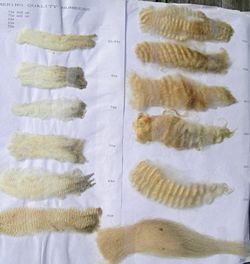
Staple (textiles)
Encyclopedia

Wool
Wool is the textile fiber obtained from sheep and certain other animals, including cashmere from goats, mohair from goats, qiviut from muskoxen, vicuña, alpaca, camel from animals in the camel family, and angora from rabbits....
fibres and not a single fibre. Very many staples together form a fleece.
- Image of the staples on the sheep (first external link below)
The cluster of wool fibres is made by a cluster of follicles. The natural cluster of wool is held together because individual fibres have the ability to attach to each other so that they stay together. When removed from the sheep the underside of the fleece shows all its distinct individual staples.
Other textiles
Staple (textiles)
A Wool Staple is a naturally formed cluster or lock of wool fibres and not a single fibre. Very many staples together form a fleece.* Image of the staples on the sheep The cluster of wool fibres is made by a cluster of follicles...
, cotton, flax etc. (evolving from the useage with wool) the staple is a measure of the quality of the fibre with regard to its length or fineness.
Etymology
Of uncertain origin but possibly a back-formation arising because part of the business of a wool-staplerWool-stapler
A wool-stapler is a dealer in wool. The wool-stapler buys wool from the producer, sorts and grades it, and sells it on to manufacturers.The expression wool-stapler fell out of use during the 20th century, see the external link below...
was to sort and class
Wool classing
Wool classing is an occupation for which people are trained to produce uniform, predictable, low risk lines of wool. This is carried out by examining the characteristics of the wool in its raw state. The characteristics which a wool classer would examine are:Breed of the sheep: Shedding breeds will...
the wool according to quality.
Staple strength
Staple strength is calculated as the force required to break per unit staple thickness, expressed as newtons per kilotex or N/tex. Position of Break (POB) is measured in conjunction with staple strength and is a measure of the position in the staple (base, mid or tip) where it will break given enough force.The staple strength of wool is one of the major determining factors when spinning
Spinning (textiles)
Spinning is a major industry. It is part of the textile manufacturing process where three types of fibre are converted into yarn, then fabric, then textiles. The textiles are then fabricated into clothes or other artifacts. There are three industrial processes available to spin yarn, and a...
yarn as well as the sale price of greasy wool.
Virtually all fleece and better grade wool skirtings sold at auction
Auction
An auction is a process of buying and selling goods or services by offering them up for bid, taking bids, and then selling the item to the highest bidder...
in Australia
Australia
Australia , officially the Commonwealth of Australia, is a country in the Southern Hemisphere comprising the mainland of the Australian continent, the island of Tasmania, and numerous smaller islands in the Indian and Pacific Oceans. It is the world's sixth-largest country by total area...
are objectively measured prior to the sale with the average results printed in a catalogue.
Forty or more staples must be measured to in order to conform to the Australian Standard. Wools under 30 newtons per kilotex are considered tender. Currently wools over 40 newtons per kilotex are preferred and attract a premium. Seasonal conditions or the health of the sheep may influence the soundness (strength) of the wool.
The Australian Standard requires that sale lot has a minimum of 55 staples measured with the average calculated and produced. The variability of this measure is reported as the coefficient of variation
Coefficient of variation
In probability theory and statistics, the coefficient of variation is a normalized measure of dispersion of a probability distribution. It is also known as unitized risk or the variation coefficient. The absolute value of the CV is sometimes known as relative standard deviation , which is...
(CV%).
Staple length
The staple length of the wool is the length of the staple, and highly correlated with mean fibre length in the top (hauteur).Staple length generally determines the end use of wool, that is, whether it will be used in weaving or knitting. The longer wools, generally around 51 mm and longer and called combing types, are processed to worsted
Worsted
Worsted , is the name of a yarn, the cloth made from this yarn, and a yarn weight category. The name derives from the village of Worstead in the English county of Norfolk...
yarn. Short stapled wools are more profitably used in the woollen
Woolen
Woolen or woollen is a type of yarn made from carded wool. Woolen yarn is soft, light, stretchy, and full of air. It is thus a good insulator, and makes a good knitting yarn...
section where high grade material may be produced from superfine wool.
Although traditionally staple length only referred to animal fibres, it is now also used when referring to manufactured fibres.
External links
- Image of the staples on the sheep
- Breeds & Wool Uses - Lists different average staple lengths for various breeds, including pictures of measured staples lengths and staple-specific spinning notes.
- Staple Length & Strength Measurement
- Wool Types - Lists characteristics of various sheep breeds, including staple lengths and descriptions.

